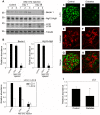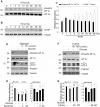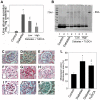Autophagy attenuates diabetic glomerular damage through protection of hyperglycemia-induced podocyte injury
- PMID: 23593240
- PMCID: PMC3623813
- DOI: 10.1371/journal.pone.0060546
Autophagy attenuates diabetic glomerular damage through protection of hyperglycemia-induced podocyte injury
Abstract
Despite the recent attention focused on the important role of autophagy in maintaining podocyte homeostasis, little is known about the changes and mechanisms of autophagy in podocyte dysfunction under diabetic condition. In this study, we investigated the role of autophagy in podocyte biology and its involvement in the pathogenesis of diabetic nephropathy. Podocytes had a high basal level of autophagy. And basal autophagy inhibition either by 3-methyladenenine (3-MA) or by Beclin-1 siRNA was detrimental to its architectural structure. However, under diabetic condition in vivo and under high glucose conditions in vitro, high basal level of autophagy in podocytes became defective and defective autophagy facilitated the podocyte injury. Since the dynamics of endoplasmic reticulum(ER) seemed to play a vital role in regulating the autophagic flux, the results that Salubrinal/Tauroursodeoxycholic acid (TUDCA) could restore defective autophagy further indicated that the evolution of autophagy may be mediated by the changes of cytoprotective output in the ER stress. Finally, we demonstrated in vivo that the autophagy of podocyte was inhibited under diabetic status and TUDCA could improve defective autophagy. Taken together, these data suggested that autophagy might be interrupted due to the failure of ER cytoprotective capacity upon high glucose induced unmitigated stress, and the defective autophagy might accelerate the irreparable progression of diabetic nephropathy.
Conflict of interest statement
Figures










Similar articles
-
Autophagy inhibition induces podocyte apoptosis by activating the pro-apoptotic pathway of endoplasmic reticulum stress.Exp Cell Res. 2014 Apr 1;322(2):290-301. doi: 10.1016/j.yexcr.2014.01.001. Epub 2014 Jan 11. Exp Cell Res. 2014. PMID: 24424244
-
Rtn1a-Mediated Endoplasmic Reticulum Stress in Podocyte Injury and Diabetic Nephropathy.Sci Rep. 2017 Mar 23;7(1):323. doi: 10.1038/s41598-017-00305-6. Sci Rep. 2017. PMID: 28336924 Free PMC article.
-
Heme oxygenase-1 enhances autophagy in podocytes as a protective mechanism against high glucose-induced apoptosis.Exp Cell Res. 2015 Oct 1;337(2):146-59. doi: 10.1016/j.yexcr.2015.04.005. Epub 2015 Apr 13. Exp Cell Res. 2015. PMID: 25882498 Review.
-
Autophagy Precedes Apoptosis in Angiotensin II-Induced Podocyte Injury.Cell Physiol Biochem. 2019;53(5):747-759. doi: 10.33594/000000170. Cell Physiol Biochem. 2019. PMID: 31622062
-
The role of autophagy in the pathogenesis of diabetic nephropathy.J Diabetes Res. 2013;2013:193757. doi: 10.1155/2013/193757. Epub 2013 Dec 17. J Diabetes Res. 2013. PMID: 24455746 Free PMC article. Review.
Cited by
-
Research Progress on the Pathological Mechanisms of Podocytes in Diabetic Nephropathy.J Diabetes Res. 2020 Jul 8;2020:7504798. doi: 10.1155/2020/7504798. eCollection 2020. J Diabetes Res. 2020. PMID: 32695831 Free PMC article. Review.
-
The complicated role of mitochondria in the podocyte.Am J Physiol Renal Physiol. 2020 Dec 1;319(6):F955-F965. doi: 10.1152/ajprenal.00393.2020. Epub 2020 Oct 19. Am J Physiol Renal Physiol. 2020. PMID: 33073585 Free PMC article.
-
Progranulin alleviates podocyte injury via regulating CAMKK/AMPK-mediated autophagy under diabetic conditions.J Mol Med (Berl). 2019 Nov;97(11):1507-1520. doi: 10.1007/s00109-019-01828-3. Epub 2019 Aug 11. J Mol Med (Berl). 2019. PMID: 31402399
-
Tangshenning Attenuates High Glucose-Induced Podocyte Injury via Restoring Autophagy Activity through Inhibiting mTORC1 Activation.J Diabetes Res. 2022 Jun 28;2022:1610416. doi: 10.1155/2022/1610416. eCollection 2022. J Diabetes Res. 2022. PMID: 35799948 Free PMC article.
-
FBW7 Regulates the Autophagy Signal in Mesangial Cells Induced by High Glucose.Biomed Res Int. 2019 Apr 21;2019:6061594. doi: 10.1155/2019/6061594. eCollection 2019. Biomed Res Int. 2019. PMID: 31119177 Free PMC article.
References
-
- Pavenstadt H, Kriz W, Kretzler M (2003) Cell biology of the glomerular podocyte. Physiol Rev 83: 253–307. - PubMed
-
- Wolf G, Chen S, Ziyadeh FN (2005) From the periphery of the glomerular capillary wall toward the center of disease: podocyte injury comes of age in diabetic nephropathy. Diabetes 54: 1626–1634. - PubMed
-
- Quaggin SE (2002) Transcriptional regulation of podocyte specification and differentiation. Microsc Res Tech 57: 208–211. - PubMed
-
- Kobayashi N (2002) Mechanism of the process formation; podocytes vs. neurons. Microsc Res Tech 57: 217–223. - PubMed
Publication types
MeSH terms
Substances
LinkOut - more resources
Full Text Sources
Other Literature Sources
Medical

